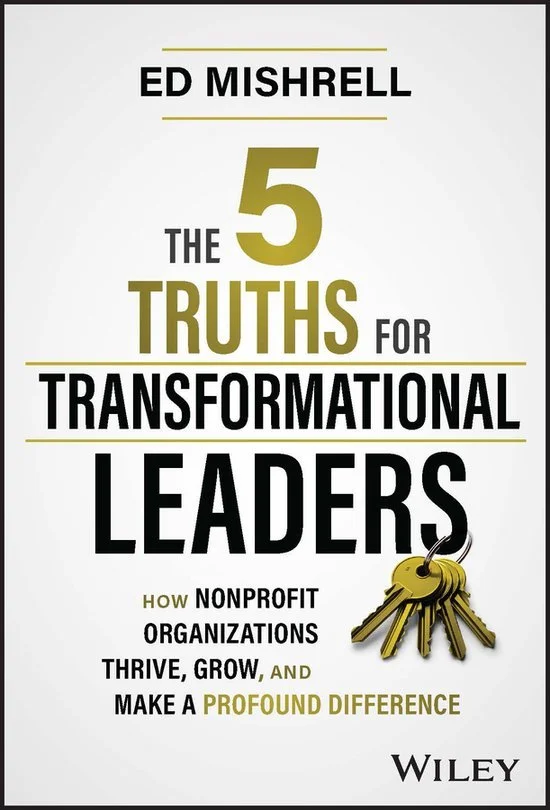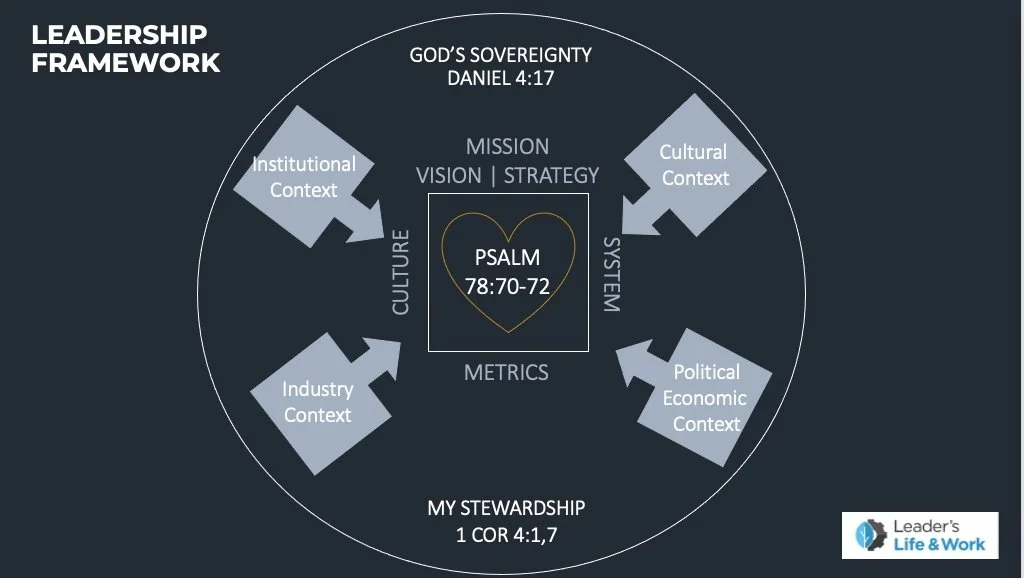By Ed Mishrell
The 5 Truths For Transformational Leaders: How Nonprofit Organizations Thrive, Grow, And Make A Profound Difference is proving to be a valuable read, and more importantly, an excellent resource for my leadership.
The 5 “truths”
Truth 1: Be fanatical about mission - “A fanatic belief in mission empowers leaders to inspire others, make difficult decisions and set high standards for services that deliver life-changing results” (3).
Truth 2: Fix, stabilize, or replace systems, practices, and people who are not working - “Only incremental improvement is possible until the organization stabilizes day-to-day operations. It is difficult to grow when every day brings a new crisis and problems to solve that could be avoided.” It is difficult to grow when leaders spend most of the day solving problems (4).
Truth 3: Establish a mission-driven strategy - Leaders develop, articulate, and align the organization on a well-reasoned strategy.
Truth 4: Execution drives results - The leader and organization stay focused on what will make the biggest difference.
Truth 5: Continue to grow as a leader - Can the leader grow with the organization and its needs? Transformational leaders are able to adapt to meet changing needs.
The 5 Truths — Methodological Approach:
Mishrell utilized a mixed methods approach, assessing both qualitative and quantitative data. Adopting a mindset that “excellence is a better teacher than mediocrity,” he studied those leaders whose organizations’ budgets grew 100% or more over a five-year period. The 5 Truths is the outcome of those interviews. Mishrell did the hard work to assess and distill what those transformational leaders did to achieve their success; we get to reap the benefits of that work.
The 5 Truths — the book’s strengths:
5 Truths focuses on smaller non-profits:
One of the strengths (and could be a drawback for some) is that Mishrell devotes pages to smaller nonprofits (budgets under $2M when the CEO who drove the change was hired) and the corresponding challenges they face. His principles, however, are solid, and apply to larger organizations as well, with the exception (at times) as to the degree of board engagement and the sharper line of demarcation that generally exists between governance and operations in larger nonprofits.5 Truths is a playbook and a toolbox: These are the two metaphors that best describe The 5 Truths for me. This book is operational knowledge and more. Mishrell provides a playbook for CEOs (he uses CPOs - Chief Professional Officers). Switching metaphors, the book itself is a toolbox for new and seasoned leaders, but especially new leaders and those who are willing to work to take their leadership to a new level.
5 Truths is a helpful benchmark: Is there any one resource that exhausts what leadership looks like in any context, much less how to do it well? The number of new volumes published annually answers that question! Still, The 5 Truths For Transformational Leaders is an excellent leadership benchmark for CEOs and CPOs (Chief Professional Officers) — nonprofit and for-profit — to assess their focus and effectiveness. Mishrell brought me back to Noel Tichy’s good work on being a learning organization and the importance of a Leader’s TPOV (teachable point of view). Samuel Johnson said, “It is more important to be reminded than instructed.” Amen to that. I needed the reminding.
5 Truths is excellent research backed by a lifetime of nonprofit leading. The reader gets the best of both careful research and the wisdom of an effective, seasoned, and savvy leader.
My Five Takeaways
1. Re-Evaluate my leadership frame
Mishell is helping me re-examine my leadership frame and encouraging me to step back to ensure that I am evaluating each aspect of that frame on a consistent basis.
Organizational flash fires, initiative imperatives, and getting stuck in the daily grind can leave little time to be a reflective practitioner. Mishrell, Max De Pree, Gordon MacDonald, J. Oswald Sanders and others have demonstrated the power of regularly taking that “view from the bridge,” and acting on what they see. I want to do the same.
Motivation must be met with Planning. Mishrell got me asking myself these questions:
How do you think about leadership? Do you have a frame?
What regular time to you have on your calendar (or will you take) to stop and assess yourself and your leadership?
What accountability mechanism do you have to ensure this gets the attention it needs?
I have worked these times of reflection into my calendar for the remainder of this year, with a note to plan them for the first quarter of 2026.
2. Move from reactive to proactive.
“It is difficult to grow when leaders spend most of the day solving problems” (4). Mishrell notes,
Leaders sometimes get stuck in the role of “Chief problem-solver.” Fixing things, solving problems, answering everyone’s questions feels rewarding. Problems are being solved; you are making a difference. . . . The result is a leader that spends most of the day directly engaged in managing operations, [rather than building] operating systems and mechanisms that ensure smooth operations with minimal daily direction from the leader.”
The solution? The right people. The right systems. The right culture. A proper sense of accountability. “Truth 2: Fix, stabilize, or replace systems, practices, and people who are not working,” provided plenty of practical help to address this challenge (82).
3. Establish and monitor succession plans at every level.
In the article, “Navigating the Leadership Vacuum,” the author notes, “the ‘Silver Tsunami’ has triggered a reduction in workforce size and a corresponding brain drain, leading to a substantial loss of critical skills, institutional knowledge, and leadership expertise.” How big is this tsunami? According to Banker’s Life, about 11,400 Americans will turn 65 every day of the year 2025 a phenomenon referred to as Peak 65. This challenge is compounded in the field of higher education, where the average tenure of a college president has slipped from 8.5 in 2006, to 6.5 in 2016, to 5.9 today.
We recognize the critical necessity of succession planning at Lancaster Bible College. Our combined full and part-time employee base totals more than 700 people. Succession planning is imperative at every position. There are multiple places in this book where I have “Succession Retreat” in the margin so that our Board of Trustees and President’s Cabinet both have a clear plan, path, and timetable to address this organizational necessity at their respective levels. For example, see:
Succession Candidate Interview Questions (19).
Succession includes proper board development (92-93).
Questions to ask about internal candidates (152).
Resources to support hiring a CPO: Again and again Mishrell either provides or points the reader to great resources like, “Top Five Ways to Mess up Hiring the Right CEO” (182).
Fanatical About Mission Worksheet. This is a great tool to assess a prospective candidate’s “mission fit” (179, 183).
4. Alignment and Partnerships, the future success of nonprofits
This was more than a passing thought in the book, but not a primary focus. It resonated with me because our institution’s Strategic Plan’s vision statement is Strengthening the foundation to be the leader in collaborative, contextual, biblical higher education.
We have been beating the collaboration drum at LBC. It is one of our core values. That’s why these words hit home: The nonprofit world is changing, and the future success of nonprofits will be defined and dominated by strategic alignments and partnerships. Funders at all levels are pushing strategic alliances. Innovation that creates social change and impact requires us to abandon our silos and fears and learn to create new partnerships” (Hansen-Turton et al., 2015, p. 3) (65).
5. Maintain a fanatical focus on mission.
Alas, if I am going to limit my takeaways to five, this is it. I lead Lancaster Bible College, a higher education institution that is enjoying and celebrating missional focus and continuity for ninety-two years. My presidential predecessors as well as our Board of Trustees have been and remain vigilant to this end. Mishrell writes that a mission-driven strategy is imperative. He notes, “It is an ongoing dynamic process built into every conversation and every meeting.” Participants in his research notes:
The CPO and the board must be able to look backward and look forward at the same time. Together board and staff leaders continuously review where we have been, determine where we want to go, and define how we will get there.
We need to understand where the organization has been and what is needed to succeed now and five years in the future. We need to take stock of what the leader will need to do to succeed now and in the future.
The focus of our organization is continuously updated based learning, experience, and evolving conditions in the operating environment (92).
Words to ponder:
On impact: “Change in transformational leadership is special, deep and broad.” James M. Burns
On excellence as a teacher: “Excellence is a better teacher than mediocrity. The lessons of the ordinary are everywhere. Truly profound and original insights are to be found only in studying the exemplary.” Warren Bennis in Organizing Genius: The Secrets of Creative Collaboration (New York: Basic Books, 1997, p. 8).
On mission: What matters is not the leader’s charisma. What matters is the leader’s mission.” Peter F. Drucker, Managing the Non-Profit Organization.
Executivitis: CEOs need to be careful not to catch a case of executivitis, which happens when the leader starts believing they have all the answers. It begins when they start to believe the praise they receive. It gets worse when the people around them provide mostly positive feedback (147).
Data-Driven Approach and why it matters: “Funders want to be able to show the resources they provide make a difference. Savvy leaders understand that making decisions based on data not only aids fundraising but also enables continuous learning about how to increase impact. Successful leaders will continue to advance and build measurement into everything the organization does” (6).
”People invest in organizations and leaders they believe will use their resources effectively. Fanatic commitment to mission tells people the leader will deploy their resources for maximum impact” (17).
The author piqued my curiosity about the following books/resources:
Good to Great and the Social Sectors monograph by Jim Collins. It’s time for a re-read.
Partnerships for Health and Human Service Nonprofits: From Collaborations to Mergers, 2015
Evaluation:
Mishrell’s approach to board engagement is more hands-on with respect to strategy. He does not seem to create or clarify that line of demarcation between governance (Board Role) and operations (CEO/Staff Role). However, given the nature of his focus on smaller nonprofits (less than $2M in operational budgets at outset), this approach makes sense (cf p. 93).
Conclusion:
Mishrell was spot on when he penned these words:
Working in a nonprofit is not for everyone. Salaries are lower, the hours can be long, and missions are challenging. It can sometimes be difficult to feel you are making a difference. It takes resilience to succeed. But the opportunity to contribute to something important is unique. This is the advantage nonprofits have in recruiting staff (71).
Resilience is necessary in any leadership role, but especially in the delightfully challenging world of nonprofits. Mishrell provides the encouragement, direction, and practical help to foster that resilience. If you lead a nonprofit, this book is a must — especially for equipping emerging leaders. If you don’t, Mishrell’s The 5 Truths For Transformational Leaders is still a go-to resource for personal and organizational effectiveness and improvement.



